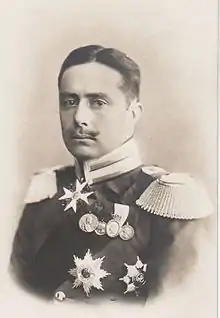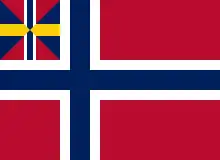William Ernest, Grand Duke of Saxe-Weimar-Eisenach
William Ernest, Grand Duke of Saxe-Weimar-Eisenach (Wilhelm Ernst Karl Alexander Friedrich Heinrich Bernhard Albert Georg Hermann, English: William Ernest Charles Alexander Frederick Henry Bernard Albert George Herman; 10 June 1876 – 24 April 1923), was the last Grand Duke of Saxe-Weimar-Eisenach.
| William Ernest | |||||
|---|---|---|---|---|---|
 | |||||
| Grand Duke of Saxe-Weimar-Eisenach | |||||
| Reign | 5 January 1901 – 9 November 1918 | ||||
| Predecessor | Charles Alexander | ||||
| Successor | Grand duchy abolished | ||||
| Born | 10 June 1876 Weimar | ||||
| Died | 24 April 1923 (aged 46) Henryków, Lower Silesian Voivodeship, Silesia | ||||
| Spouse | |||||
| Issue |
| ||||
| |||||
| House | House of Saxe-Weimar-Eisenach | ||||
| Father | Charles Augustus, Hereditary Grand Duke of Saxe-Weimar-Eisenach | ||||
| Mother | Princess Pauline of Saxe-Weimar-Eisenach | ||||
| Religion | Lutheranism | ||||
Biography
He was born in Weimar, the eldest son of Karl August of Saxe-Weimar-Eisenach, heir to the Grand Duke, and his wife Princess Pauline of Saxe-Weimar-Eisenach.
He succeeded his grandfather Karl Alexander as Grand Duke on 5 January 1901, as his father had predeceased him.
His heir was a distant cousin, Prince Hermann of Saxe-Weimar-Eisenach, until his disinheritance in 1909. Hermann's younger brother subsequently served as heir presumptive to the Grand Duchy of Saxe-Weimar-Eisenach until the birth of William Ernest's eldest son.
Wilhelm Ernst created the new Weimar town centre under the direction of Hans Olde, Henry van de Velde, and Adolf Brütt. He also had the University of Jena rebuilt by Theodor Fischer and also reconstructed Weimar's theatres. The improvements to the city included a marble statue of his predecessor Charles Alexander, which was completed in 1911. It was placed in a setting designed by Brütt. The placement of the setting was designed to distinguish the "old town" from the newly built area. A preservation law for the "old town" barred it to the "art nouveau"-style which was used in the new area.
The Dutch throne
According to the Dutch constitution, Wilhelm Ernst was in the line for the throne of the Netherlands (as the grandson of Princess Sophie of the Netherlands) after Queen Wilhelmina. At the beginning of the 20th century, the Dutch feared the possibility of German influence or even annexation of the Netherlands. In order to prevent this, some lawyers tried to change the constitution to exclude Wilhelm Ernst from the succession. Another proposal, however, was this: if Wilhelmina would die childless, then he or his offspring would have to choose between the Dutch and the Weimar throne. The birth of Wilhelmina's daughter Juliana in 1909 lessened the chance for any member of the House of Wettin (Saxe-Weimar-Eisenach branch) to inherit the Dutch throne. With the amendment to the constitution of 1922, which restricted the right of succession to the offspring of Wilhelmina, the possibility disappeared entirely.
Abdication
On 9 November 1918, Grand Duke Wilhelm Ernst - along with the rest of the German monarchs following the defeat of Germany in World War I - was forced to abdicate. His throne and all his lands were relinquished and he fled with his family to the family estate in Silesia, where he died five years later.
Despite all his work for Weimar during his government, Wilhelm Ernst was a hated ruler. This was for his private life, where he was known to be a sadist; the day of his abdication, he was called the "most unpopular prince in all Germany".[1]
He died in Heinrichau in Silesia.
Family and children
In Bückeburg on 30 April 1903 Wilhelm Ernst married first to Princess Caroline Reuss of Greiz, a daughter of Prince Heinrich XXII Reuss of Greiz. This marriage was childless and ended in 1905 with the death of Caroline under mysterious circumstances. The official cause of death was pneumonia following influenza; other sources have suggested suicide.
In Meiningen on 21 January 1910, Wilhelm Ernst married second to Princess Feodora of Saxe-Meiningen, daughter of Prince Friedrich Johann of Saxe-Meinigen.
They had four children:
| Name | Birth | Death | Notes |
|---|---|---|---|
| Princess Sophia of Saxe-Weimar-Eisenach | 20 March 1911 | 21 November 1988 | married Friedrich Günther, Prince of Schwarzburg; the marriage ended in divorce less than a year later. There were no children. |
| Karl August, Hereditary Grand Duke of Saxe-Weimar-Eisenach | 28 July 1912[2] | 14 October 1988 | married Baroness Elisabeth of Wangenheim-Winterstein; had issue |
| Prince Bernhard of Saxe-Weimar-Eisenach | 3 March 1917 | 23 March 1986 | His daughter Katharina Feodora Adelheid Sabine Sophie Felicitas Sieglinde, Princess of Saxe-Weimar-Eisenach (born 30 November 1943) married Prince Emanuel Joseph von Hohenzollern-Emden, son of Franz Joseph, Prince of Hohenzollern-Emden, on 25 May 1968 (divorced in 1985) |
| Prince Georg of Saxe-Weimar-Eisenach | 24 November 1921 | 11 March 2011 | changed name for Jörg Brena in 1953 and renounced his succession rights |
Honours
He received the following orders and decorations:[3]
.svg.png.webp) Saxe-Weimar-Eisenach: Grand Cross of the White Falcon, 1894;[4] Grand Master, 5 January 1901
Saxe-Weimar-Eisenach: Grand Cross of the White Falcon, 1894;[4] Grand Master, 5 January 1901.svg.png.webp)
.svg.png.webp)
.svg.png.webp) Ernestine duchies: Grand Cross of the Saxe-Ernestine House Order
Ernestine duchies: Grand Cross of the Saxe-Ernestine House Order.svg.png.webp) Kingdom of Saxony: Knight of the Rue Crown, 1898[5]
Kingdom of Saxony: Knight of the Rue Crown, 1898[5] Duchy of Anhalt: Grand Cross of the Order of Albert the Bear
Duchy of Anhalt: Grand Cross of the Order of Albert the Bear.svg.png.webp) Baden: Knight of the House Order of Fidelity, 1901[6]
Baden: Knight of the House Order of Fidelity, 1901[6].svg.png.webp) Kingdom of Bavaria: Knight of St. Hubert, 1901[7]
Kingdom of Bavaria: Knight of St. Hubert, 1901[7] Brunswick: Grand Cross of the Order of Henry the Lion, 1902[8]
Brunswick: Grand Cross of the Order of Henry the Lion, 1902[8] Grand Duchy of Hesse: Grand Cross of the Ludwig Order, 20 February 1902[9]
Grand Duchy of Hesse: Grand Cross of the Ludwig Order, 20 February 1902[9] Principality of Lippe: Cross of Honour of the House Order of Lippe, 1st Class
Principality of Lippe: Cross of Honour of the House Order of Lippe, 1st Class Mecklenburg: Grand Cross of the Wendish Crown
Mecklenburg: Grand Cross of the Wendish Crown Oldenburg: Grand Cross of the Order of Duke Peter Friedrich Ludwig, with Collar
Oldenburg: Grand Cross of the Order of Duke Peter Friedrich Ludwig, with Collar.svg.png.webp) Kingdom of Prussia:
Kingdom of Prussia:
- Knight of the Black Eagle, with Collar, 18 January 1897[10]
- Grand Commander's Cross of the Royal House Order of Hohenzollern

 Reuss: Cross of Honour, 1st Class with Crown
Reuss: Cross of Honour, 1st Class with Crown Württemberg: Grand Cross of the Württemberg Crown, 1895[11]
Württemberg: Grand Cross of the Württemberg Crown, 1895[11]
.svg.png.webp) Austria-Hungary: Grand Cross of the Royal Hungarian Order of St. Stephen, 1901[12]
Austria-Hungary: Grand Cross of the Royal Hungarian Order of St. Stephen, 1901[12] Principality of Bulgaria: Grand Cross of St. Alexander
Principality of Bulgaria: Grand Cross of St. Alexander Netherlands:
Netherlands:
- Grand Cross of the Netherlands Lion
- Grand Cross of the Order of Orange-Nassau
 Russian Empire:
Russian Empire:
- Knight of St. Andrew, 1901
- Knight of St. Alexander Nevsky, 1901
.svg.png.webp)
 Sweden-Norway: Knight of the Seraphim, 18 September 1897[13]
Sweden-Norway: Knight of the Seraphim, 18 September 1897[13]
Ancestry
References
- "The Most Unpopular Prince in Germany': Grand Duke Wilhelm Ernst of Saxe-Weimar-Eisenach", European Royal History Journal (XIV): 24–26, December 1999
- "Son Born to Grand Duchess", The Washington Post, Eisenach, Germany, 29 July 1912
- Staatshandbuch für das Großherzogtum Sachsen / Sachsen-Weimar-Eisenach (1913), "Genealogie" pp. 1-2
- Staatshandbuch ... Sachsen / Sachsen-Weimar-Eisenach (1900), "Großherzoglicher Hausorden" p. 15
- Sachsen (1901). "Königlich Orden". Staatshandbuch für den Königreich Sachsen: 1901. Dresden: Heinrich. p. 5 – via hathitrust.org.
- Hof- und Staats-Handbuch des Großherzogtum Baden (1910), "Großherzogliche Orden" p. 41
- Hof- und Staats-Handbuch des Königreich Bayern (1906), "Königliche Orden" p. 8
- Hof- und Staatshandbuch des Herzogtums Braunschweig für 1905. Braunschweig 1905. Meyer. p. 11
- "Ludewigs-orden", Großherzoglich Hessische Ordensliste (in German), Darmstadt: Staatsverlag, 1914, p. 6 – via hathitrust.org
- "Schwarzer Adler-orden", Königlich Preussische Ordensliste (in German), vol. 1, Berlin, 1895, p. 5 – via hathitrust.org
{{citation}}: CS1 maint: location missing publisher (link) - Hof- und Staats-Handbuch des Königreich Württemberg (1896), "Königliche Orden" p. 29
- "A Szent István Rend tagjai" Archived 22 December 2010 at the Wayback Machine
- Sveriges statskalender (in Swedish), 1905, p. 441, retrieved 8 March 2021 – via runeberg.org